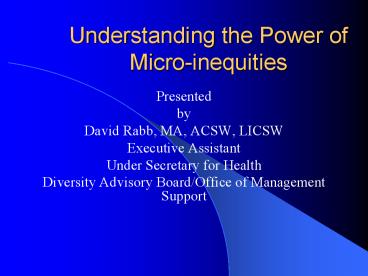Understanding the Power of Microinequities - PowerPoint PPT Presentation
1 / 26
Title:
Understanding the Power of Microinequities
Description:
Examine definition and explore concepts surrounding micro-inequities ... between rude behavior and micro-inequities is that rude behaviors happen occasionally. ... – PowerPoint PPT presentation
Number of Views:3189
Avg rating:3.0/5.0
Title: Understanding the Power of Microinequities
1
Understanding the Power of Micro-inequities
- Presented
- by
- David Rabb, MA, ACSW, LICSW
- Executive Assistant
- Under Secretary for Health
- Diversity Advisory Board/Office of Management
Support
2
Purpose
- To provide an understanding of and an
appreciation for how micro-inequities affect
people at home,at work, and at play.
3
Outline
- Examine definition and explore concepts
surrounding micro-inequities - Provide example of micro-inequities
- Explore what we can do to minimize the effects of
micro-inequities
4
Think Back
- Take time to reflect on a time when you felt
deeply valued by your boss or co-workers. What
was the situation and how did your boss or
co-workers show you that they valued you or your
contributions? - (3 minutes each)
5
Communication
- The most powerful aspect of communication is not
verbal communication but nonverbal. It is
estimated that most adults receive and send - 2, 000 to 4, 000 micro-messages (subtle nonverbal
signals) in a day.
6
(No Transcript)
7
Micro-inequities
- Verbal or non verbal
- Conscious or unconscious
- Subtle or non-subtle
- Behavior (s) meant to discourage
8
Definition
- Micro-inequities Cumulative pattern of subtle,
semi-conscious, devaluing messages which
discourage and impair performance.
9
Background
- In 1973, while researching racial and gender
exclusion in the workplace, Mary Rowe, Ph.D.
discovered that women and people of color were
bothered by subtle, seemingly harmless messages
of devaluation that kept them from flourishing.
10
Examples of Micro-inequities
- Constantly being interrupted while you are
talking - Being left out of a discussion/project
- Trying to speak with someone who is
reading/sending e-mails during conversation - Talking with someone who keeps looking at his/her
watch - Not being introduced in a meeting and then being
ignored
11
Examples of Micro-inequities
- Avoidance of eye contact
- Rolling of the eyes
- Cutting down ideas before they can be entertained
- Staying on the cell phone with no explanation
- Mispronouncing your name or misspelling your
name
12
Examples of Micro-inequities
- Change in voice pitch, volume, or rate
- Change in body posture
- Change in hand movements and gestures
- Fake, masked or forced smiles
13
Tell Me A Story
- Please pair up with someone and share with him or
her a time when a micro-inequity was directed
towards you or you witnessed a micro-inequity. - (3 minutes)
14
Micro-inequities vs. Rudeness
- The difference between rude behavior and
micro-inequities is that rude behaviors happen
occasionally. Micro-inequities happen constantly
and have a way of boxing a person in or creating
a less than positive cultural climate.
15
- Death by a thousand cuts
- -Alvin Poussaint, Psychologist, Author
16
Exercise
- Pair up with someone in the room.
- Take three minutes as a speaker and then switch
partners and become the listener. - The speaker will communicate to the listener
three things that he/she did last week. The
listener will send as many negative
micro-messages as they can in three minutes.
17
Question?
- What are the potential risks of failing to
confront or manage micro-inequities in the
workplace?
18
Examples of Negative Effects of Micro-inequities
- A feeling of being devalued
- Low self-esteem
- Decreased morale
- A sense that you not being listened to
- Poor interpersonal relationships
19
Examples of Negative Effects of Micro-inequities
- Decrease in speaking/sharing ideas
- Decrease in taking risks
- Decrease in productivity
- Increase in discrimination complaints
- Poor retention and recruitment
- High turnover
20
Things To Consider?
- What positive and supportive behaviors do you see
working for you and your team in your work
environment? - What behaviors get in your/or your teams way in
reaching mutual respect, positive regards, and
good outcomes in your work setting? - What needs to change?
21
Self
- I count him braver who overcomes his desires
than him who conquers his enemies, for the
hardest victory is over self. - -Aristotle
22
- It takes a variety of
- people to challenge us,
- encourage us, promote
- us, and most of all, help
- us achieve a broader
- dimension of ourselves.
- Glenn Van Ekeren
23
Ways to Minimize Micro-inequities
- Become aware of your own stereotypes, prejudices,
and limitations - Be aware of your micro-triggers
- Be open to feedback from others
- Be able to forgive yourself and others
- Be able to interrupt micro-inequities and turn
them into micro-advantages
24
Micro-advantage
25
Ways to Minimize Micro-inequities
- Be unwilling to be merely a bystander when you
see micro-inequities occurring - Be willing to A.C.T. and seek F.A.C.T. S.
- Be inclusive. Help people feel welcomed
- Be willing to learn more about this topic and
share what you know about the topic
26
Resources
- Communication in a Diverse Workplace by Lillian
A. Kuga - Cultural Diversity in the Workplace by Sally J.
Walton - Developing Competency to Manage Diversity by
Taylor Cox, Jr., Ruby L. Beale
27
Summary
- Microinequities can have a profound impact on how
we relate with one another. Now that you are
more aware of this topic, you should be able to
recognize subtle forms of micro-inequities in
your world and to respond appropriately.
28
Conclusion
- How far you go in life depends on your being
tender with the young, compassionate with the
aged, sympathetic with the striving and tolerant
of the weak and strong, because someday in life
you will have been all of these. - -George Washington Carver































